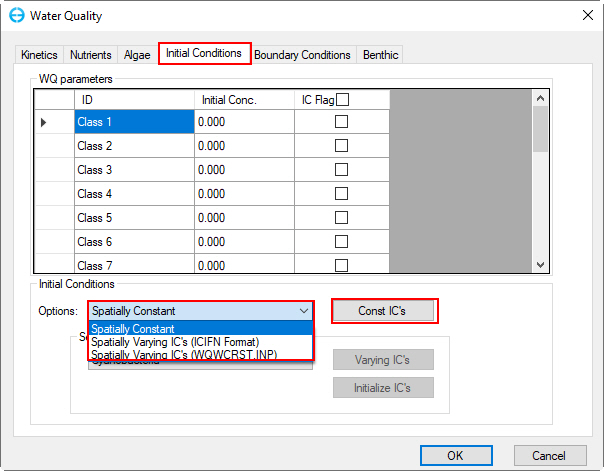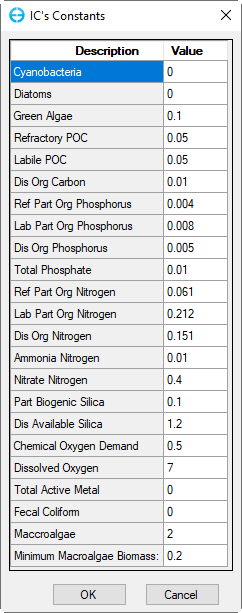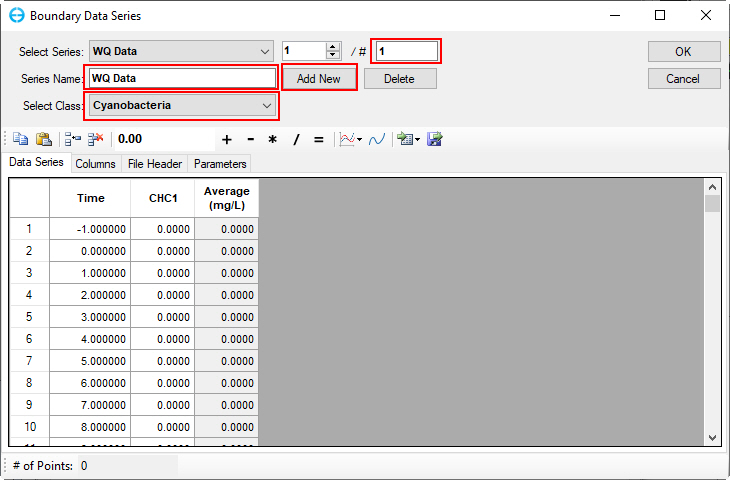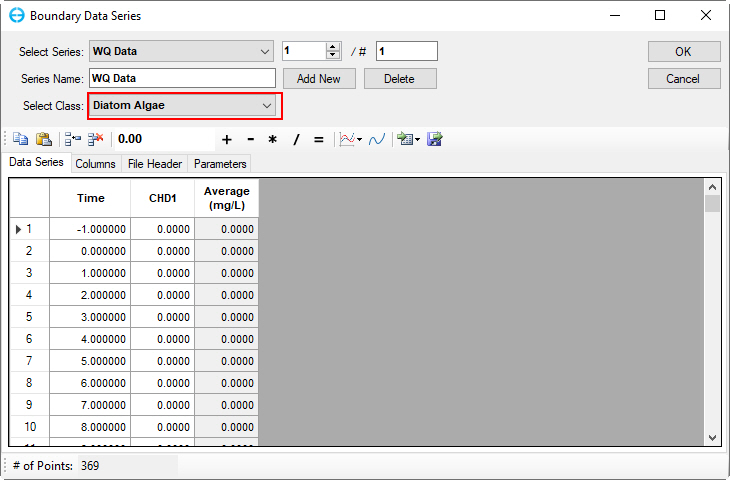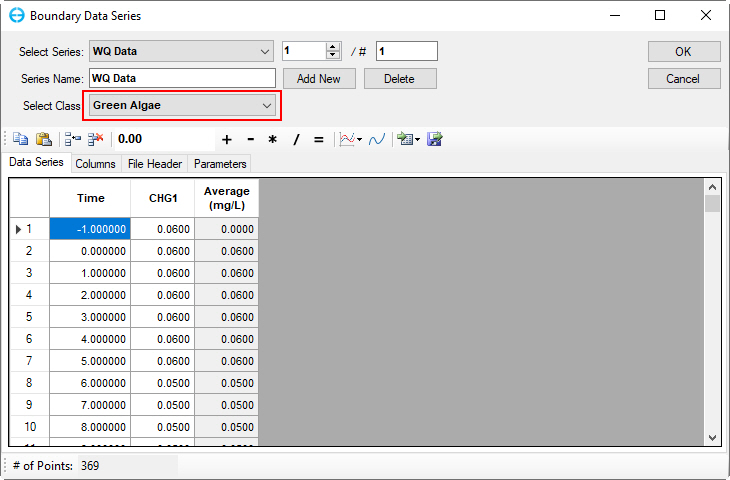...
Proceed to the Nutrients tab as shown in Figure 26; in Sorption Option select Total Active Metal (TAM) Based then (1) click Modify Parameters buttons to edit Nutrient Sorption Parameters Figure 27, in Nutrient Options and Parameters frame (2) click Carbon button to edit the Carbon parameters Figure 28; (3) Nitrogen button to edit the Nitrogen parameters Figure 29; (4) Phosphorus button to edit the Phosphorus parameters Figure 30; (5) COD&DO button to edit the COD&DO parameters Figure 31.
Anchor Figure 26 Figure 26
Figure 26. Water Quality Tab: Nutrients.
Anchor Figure 27 Figure 27
Figure 27. Nutrients: (1) Nutrient Sorption Parameters.
Anchor Figure 28 Figure 28
Figure 28. Nutrients: (2) Carbon Parameters.
Anchor Figure 29 Figure 29
Figure 29. Nutrients: (3) Nitrogen Parameters.
Anchor Figure 30 Figure 30
Figure 30. Nutrients: (4) Phosphorus Parameters.
Anchor Figure 31 Figure 31
Figure 31. Nutrients: (5) COD and DO Parameters
...
Proceed to the Algae tab which is shown in Figure 32; in the Solar Radiation for Algae frame, select source drop-down and select Constant, then click (1) Modify button to edit solar radiation parameters as shown in Figure 33. In Algae Options, click (2) Algal Dynamics button to edit Algal Growth Parameters, Global Setting shown in Figure 34; (3) Stoichiometry button to edit Algal Growth/Decay Stoichiometry Constants shown in Figure 35; (4) Temperature button to edit Algal Growth Temperature Constants shown in Figure 36; (5) Half-Saturation button to edit Algal Half-Saturation Constants shown in Figure 37; (6) Light Extinction button to edit Light Extinction Options shown in Figure 38; (7) Optimal Depths button to edit Algal Growth Optimal Depths shown in Figure 39.
Anchor Figure 32 Figure 32
Figure 32. Water Quality Tab: Algae.
Anchor Figure 33 Figure 33
Figure 33. Algae: (1) Solar Radiation Options.
Anchor Figure 34 Figure 34
Figure 34. Algae: (2) Algal Dynamics Growth Parameters.
Anchor Figure 35 Figure 35
Figure. 35 Algae: (3) Algal Stoichiometry.
Anchor Figure 36 Figure 36
Figure 36. Algae: (4) Algal Temperature.
Anchor Figure 37 Figure 37
Figure 37. Algae: (5) Algal Half-Saturation.
Anchor Figure 38 Figure 38
Figure 38. Algae: (6) Algal Light Extinction.
Anchor Figure 39 Figure 39
Figure 39. Algae: (7) Algal Optimal Depths.
...
Proceed to the Initial Conditions tab as shown in Figure 40. In Initial Conditions frame, click on drop-down menu and select Spatially Constant, then click Const IC's button to edit each of the water quality parameters Figure 41.
Anchor Figure 40 Figure 40
Figure 40. Water Quality Tab: Initial Conditions.
Anchor Figure 41 Figure 41
Figure 41. WQ Initial Conditions Parameters.
...
1. Proceed to the Boundary Conditions tab as shown in Figure 42; Click the Edit button in the Time series Data frame to open Boundary Data Series form which is shown in Figure 43.
Anchor Figure 42 Figure 42
Figure 42. Water Quality Tab: Boundary Conditions.
...
2. Set the number of series to 1 in # box or click on Add New button to add a data series. Set the Series Name to "WQ Data" and type or copy and paste into the form for the time and cyanobacteria data as shown in Figure 43.
Anchor Figure 43 Figure 43
Figure 43. Boundary Condition Settings: Cyanobacteria Data Series.
...
3. Click on Select Class drop-down menu to select other parameters. Copy and paste into the form for the time and water quality parameter data. An example of the diatom algae parameter is shown in Figure 44.
Anchor Figure 44 Figure 44
Figure 44. Boundary Condition Settings: Diatom algae Data Series.
...
3) Green algae | Figure 45 | 13) Dissolved organic nitrogen | Figure 55 |
4) Refractory particulate organic carbon | Figure 46 | 14) Ammonia nitrogen | Figure 56 |
5) Labile particulate organic carbon | Figure 47 | 15) Nitrate nitrogen | Figure 57 |
6) Dissolved carbon | Figure 48 | 16) Particulate biogenic silica | Figure 58 |
7) Refractory part. organic phosphorus | Figure 49 | 17) Dissolved available silica | Figure 59 |
8) Labile particulate organic phosphorus | Figure 50 | 18) Chemical oxygen demand | Figure 60 |
9) Dissolved organic phosphorus | Figure 51 | 19) Dissolved oxygen | Figure 61 |
10) Total phosphate | Figure 52 | 20) Total active metal | Figure 62 |
11) Refractory part. Org. nitrogen | Figure 53 | 21) Fecal coliform bacteria | Figure 63 |
12) Labile part. organic nitrogen | Figure 54 |
Anchor Figure 45 Figure 45
Figure 45. Boundary Condition Settings: green algae.
...














